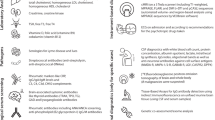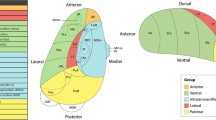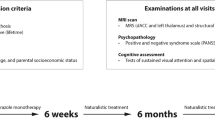Abstract
The role of glutamatergic dysfunction in the pathophysiology of OCD has hardly been explored despite recent reports implicating glutamatergic dysfunction in OCD. We decided to investigate CSF glutamate levels in adult OCD probands compared to psychiatrically normal controls. In total, 21 consenting psychotropic drug-naïve adult OCD patients, diagnosed using SCID-IV-CV, and 18 consenting psychiatrically normal controls with age within 10 years of age of the patients, who did not have any history of head injury or neurological illness, were included into the study. Aseptically collected and stored CSF samples obtained from the patients and control subjects were used for glutamate estimation, which was carried out by a modification of the procedure described by Lund (1986). CSF glutamate (μmol/l) level was found to be significantly higher [F(1,31)=6.846, p=0.014] in OCD patients (47.12±4.25) compared to control subjects (41.36±3.63) on analysis of covariance. There was no effect of gender, age, duration of illness, Y-BOCS score, or CGI-S score on CSF glutamate levels. Our study provides preliminary evidence implicating glutamatergic excess in the pathophysiology of OCD, which needs to be further explored by studies from other centers involving larger sample sets from different age groups.
Similar content being viewed by others
Log in or create a free account to read this content
Gain free access to this article, as well as selected content from this journal and more on nature.com
or
References
Alexander GE, DeLong MR, Strick PL (1986). Parallel organization of functionally segregated circuits linking basal ganglia and cortex. Annu Rev Neurosci 9: 357–381.
Altemus M, Fong J, Yang R, Damast S, Luine V, Ferguson D (2004). Changes in cerebrospinal fluid neurochemistry during pregnancy. Biol Psychiatry 56: 386–392.
Altemus M, Pigott T, Kalogeras KT, Demitrack M, Dubbert B (1992). Abnormalities in the regulation of vasopressin and corticotropin releasing factor secretion in obsessive-compulsive disorder. Arch Gen Psychiatry 49: 9–20.
Anesi A, Rondanelli M, d'Eril GM (1998). Stability of neuroactive amino acids in cerebrospinal fluid under various conditions of processing and storage. Clin Chem 44: 2359–2360.
Bolton J, Moore GJ, MacMillan S, Stewart CM, Rosenberg DR (2001). Case study: caudate glutamatergic changes with paroxetine persist after medication discontinuation in pediatric OCD. J Am Acad Child Adolesc Psychiatry 40: 903–906.
Charney DS, Heninger GR, Sternberg DE, Redmond DE, Leckman JF, Maas JW, Roth RH (1981). Presynaptic adrenergic receptor sensitivity in depression. The effect of long-term desipramine treatment. Arch Gen Psychiatry 38: 1334–1340.
Faustman WO, Bardgett M, Faull KF, Pfefferbaum A, Csernansky JG (1999). Cerebrospinal fluid glutamate inversely correlates with positive symptom severity in unmedicated male schizophrenic/schizoaffective patients. Biol Psychiatry 45: 68–75.
Ferrarese C, Pecora N, Frigo M, Appollonio I, Frattola L (1993). Assessment of reliability and biological significance of glutamate levels in cerebrospinal fluid. Ann Neurol 33: 316–319.
Ferraro TN, Hare TA (1985). Free and conjugated amino acids in human CSF: influence of age and sex. Brain Res 338: 53–60.
First MB, Spitzer RL, Gibbon M, Williams JBW (1997). Structured Clinical Interview for DSM-IV Axis I Disorders-Clinician Version (SCID-CV). American Psychiatric Press: Washington, DC.
Garvey MJ, Tuason VB, Johnson RA, Valentine RH, Cooper TB (1984). Elevated plasma tricyclic levels with therapeutic doses of imipramine. Am J Psychiatry 141: 853–856.
Gattaz WF, Gattaz D, Beckmann H (1982). Glutamate in schizophrenics and healthy controls. Arch Psychiatr Nervenkr 231: 221–225.
Gjessing LR, Gjesdahl P, Dietrichson P, Presthus J (1974). Free amino acids in the cerebrospinal fluid in old age and in Parkinson's disease. Eur Neurol 12: 33–37.
Goodman WK, Price LH, Rasmussen SA, Mazure C et al (1989a). The Yale-Brown obsessive-compulsive scale: I. Development, use and reliability. Arch Gen Psychiatry 46: 1006–1011.
Goodman WK, Price LH, Rasmussen SA, Mazure C et al (1989b). The Yale-Brown obsessive-compulsive scale: II. Validity. Arch Gen Psychiatry 46: 1012–1016.
Goodnick PJ, Evans HE, Dunner DL, Fieve RR (1980). Amino acid concentrations in cerebrospinal fluid: effects of aging, depression, and probenecid. Biol Psychiatry 15: 557–563.
Griest JH, Jefferson JW, Kobak KA, Katzelnick DJ, Serlin RC (1995). Efficacy and tolerability of serotonin transport inhibitors in obsessive-compulsive disorder. A meta-analysis. Arch Gen Psychiatry 52: 53–60.
Hagenfeldt L, Bjerkenstedt L, Edman G, Sedvall G, Weisel FA (1984). Amino acid in plasma and CSF and monoamine metabolites in CSF: interrelationship in healthy subjects. J Neurochem 42: 833–837.
Hill KK, West SA, Ekhator NN, Bruce AB, Wortman MD, Bake DG et al (1999). The effect of lumbar puncture stress on dopamine and serotonin metabolites in human cerebrospinal fluid. Neurosci Lett 276: 25–28.
Ijima K, Takase S, Tsumuraya K et al (1978). Changes in free amino acids of cerebrospinal fluid and plasma in various neurological diseases. Tohuku J Exp Med 126: 133–150.
Insel TR, Mueller EA, Alterman I, Linnoila M, Murphy DL (1985). Obsessive-compulsive disorder and serotonin: is there a connection? Biol Psychiatry 20: 1174–1188.
Keuler DJ, Altemus M, Michelson D, Greenberg B, Murphy DL (1996). Behavioral effects of naloxone infusion in obsessive-compulsive disorder. Biol Psychiatry 40: 154–156.
Kim JS, Kornhuber HH, Schmid-Burgk W, Holzmuller B (1980). Low cerebrospinal fluid glutamate in schizophrenic patients and a new hypothesis on schizophrenia. Neurosci Lett 20: 379–382.
Kornhuber ME, Kornhuber J (1992). Cerebrospinal fluid amino acids in amyotrophic lateral sclerosis. Ann Neurol 31: 449–450.
Korpi ER, Kaufmann CA, Marnela KM, Weinberger DR (1987). Cerebrospinal fluid amino acid concentrations in chronic schizophrenia. Psychiatry Res 20: 337–345.
Labarca R, Silva H, Jerez S, Ruiz A, Renterias P, Ogalde C et al (1995). Effects of haloperidol on CSF glutamate levels in drug-naive schizophrenic patients. Schizophr Res 16: 83–85.
Lakke JP, Teelken AW (1976). Amino acid abnormalities in cerebrospinal fluid of patients with parkinsonism and extrapyramidal disorders. Neurology 26: 489–493.
Leckman JF, Goodman WK, Anderson GM, Riddle MA, Chappell PB, McSwiggan-Hardin MT et al (1995). Cerebrospinal fluid biogenic amines in obsessive compulsive disorder, Tourette's syndrome, and healthy controls. Neuropsychopharmacology 12: 73–86.
Leckman JF, Goodman WK, North WG, Chappell PB, Price LH, Pauls DL et al (1994). The role of central oxytocin in obsessive compulsive disorder and related normal behavior. Psychoneuroendocrinology 19: 723–749.
Lund P (1986). L-Glutamine and L-Glutamate: UV method with Glutaminase and Glutamate Dehydrogenase. In: Bergmeyer HU (ed). Methods in Enzymatic Analysis, Vol 8. VCH, Verlagsgesellschaft: Weinhein. pp 357–363.
McGale EH, Pye IF, Stonier C, Hutchinson EC, Aber GM (1977). Studies of the inter-relationship between cerebrospinal fluid and plasma amino acid concentrations in normal individuals. J Neurochem 29: 291–297.
McGrath MJ, Campbell KM, Parks III CR, Burton FH (2000). Glutamatergic drugs exacerbate symptomatic behaviour in transgenic model of comorbid Tourette's syndrome and obsessive-compulsive disorder. Brain Res 877: 23–30.
Mellstrom B, Alvan G, Bertilsson L, Potter WZ, Sawe J, Sjoqvist F (1982). Nortriptyline formation after single oral and intramuscular doses of Amitryptyline. Clin Pharmacol Ther 32: 664–667.
Montgomery SA (1994). Pharmacological treatment of obsessive-compulsive disorder. In: Hollander E, Zohar J, Marazziti D, Olivier B (eds). Current Insights in Obsessive-Compulsive Disorder. Wiley: Chichester. pp 215–226.
Moore GJ, MacMaster FP, Stewart C, Rosenberg DR (1998). Case study: caudate glutamatergic changes with paroxetine therapy for pediatric obsessive-compulsive disorder. J Am Acad Child Adolesc Psychiatry 37: 663–667.
Parent A, Hazrati LN (1995). Functional anatomy of the basal ganglia. I. The cortico-basal ganglia-thalamo cortical loop. Brain Res Brain Res Rev 20: 91–127.
Rosenberg DR, MacMaster FP, Keshavan MS, Fitzgerald KD, Stewart CM, Moore GJ (2000). Decrease in caudate glutamatergic concentrations in pediatric obsessive-compulsive disorder patients taking paroxetine. J Am Acad Child Adolesc Psychiatry 39: 1096–1103.
Rothstein JD, Martin LJ, Kuncl RW (1992). Decreased glutamate transport by the brain and spinal cord in amyotrophic lateral sclerosis. N Engl J Med 326: 1464–1468.
Sasson Y, Zohar J (1996). New developments in obsessive-compulsive disorder research: implications for clinical management. Int Clin Psychopharmacol Suppl 5: 3–12.
Saxena S, Brody AL, Schwartz JM, Baxter LR (1998). Neuroimaging and frontal-subcortical circuitry in obsessive-compulsive disorder. Br J Psychiatry 173 (suppl 35): 26–37.
Saxena S, Rauch SL (2000). Functional neuroimaging and the neuroanatomy of obsessive-compulsive disorder. Psychiatr Clin N Am 23: 563–586.
Stein DJ, Spadaccini E, Hollander E (1995). Meta-analysis of pharmacotherapy trials for obsessive-compulsive disorder. Int Clin Psychopharmacol 10: 11–18.
Swedo SE, Leonard HL, Kruesi MJ, Rettew DC, Listwak SJ, Berrettini W et al (1992). Cerebrospinal fluid neurochemistry in children and adolescents with obsessive-compulsive disorder. Arch Gen Psychiatry 49: 29–36.
Thoren P, Asberg M, Bertilsson L, Mellstrom B, Sjovist F, Traskman L (1980). Clomipramine treatment of obsessive-compulsive disorder. II. Biochemical aspects. Arch Gen Psychiatry 37: 1289–1294.
Author information
Authors and Affiliations
Corresponding author
Additional information
Work done at Biological Psychiatry Lab, Nimhans, Bangalore, India.
Rights and permissions
About this article
Cite this article
Chakrabarty, K., Bhattacharyya, S., Christopher, R. et al. Glutamatergic Dysfunction in OCD. Neuropsychopharmacol 30, 1735–1740 (2005). https://doi.org/10.1038/sj.npp.1300733
Received:
Revised:
Accepted:
Published:
Issue date:
DOI: https://doi.org/10.1038/sj.npp.1300733
Keywords
This article is cited by
-
Polygenetic risk scores and phenotypic constellations of obsessive–compulsive disorder in clozapine-treated schizophrenia
European Archives of Psychiatry and Clinical Neuroscience (2024)
-
Blood glutamate scavenging as a novel glutamate-based therapeutic approach for post-traumatic brain injury anxiety and social impairment
Translational Psychiatry (2023)
-
Cortical glutamate and GABA are related to compulsive behaviour in individuals with obsessive compulsive disorder and healthy controls
Nature Communications (2023)
-
Glucose metabolism and AD: evidence for a potential diabetes type 3
Alzheimer's Research & Therapy (2022)
-
Possible actions of cannabidiol in obsessive-compulsive disorder by targeting the WNT/β-catenin pathway
Molecular Psychiatry (2022)



